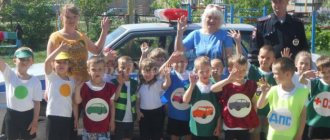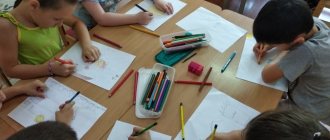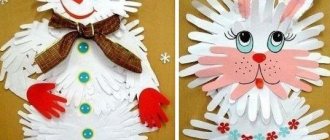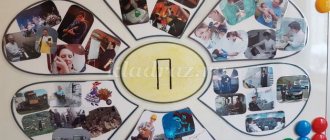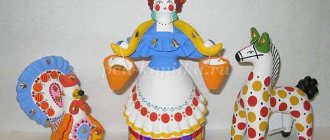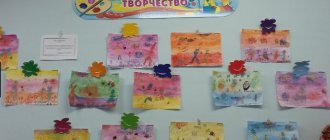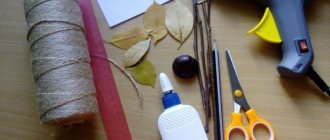Mathematical KVN for older preschoolers
Mathematical KVN in kindergarten. Scenario
Mathematical KVN for children of senior preschool age
Objectives: 1. bring children joy and pleasure from educational games. 2. support children’s interest in intellectual activity, manifestations of intelligence, perseverance, determination and ingenuity. 3. develop logical thinking in children. 4. consolidate the names of geometric shapes. Equipment: badges with children's names, posters with images of geometric figures, 2 sheets of whatman paper with images of geometric figures, 14 markers, 13 geometric figures for the game "Tangram", a fairy-tale character, medals for each team member.
KVN progress:
The teams enter the hall to the music. Host: Friends, today you came to our fun KVN. We brought you a smile, so that you smile every day. So, today two teams are competing in the club of cheerful and resourceful people: the “Clever” team and the “Clever” team. Your knowledge will be assessed by a distinguished jury (represented by the jury members). The first competition is called “Riddles about numbers.” Raise your hand, answer quickly, And now we’ll ask the jury - award points! The first riddle for the "Umniki" team. How many suns are there behind a cloud, How many refills are there in a pen, How many noses does an elephant have, How many watches are there on a hand, The number-column knows and is proud of itself... (one) And now a riddle for the “Clever Girls” team. How many months are there in winter, In summer, in autumn, in spring, How many eyes do traffic lights have, Bases on a baseball field, Edges on a sports sword And stripes on our flag, No matter what anyone tells us, The number knows the truth... (three). The next riddle is for the Smarties team. How many fingers are there on the hand And pennies in the snout, The rays of the starfish, The beaks of the five rooks, The blades of the maple leaves, And the corners of the bastion, A number will help us tell us about all this... (five) Team “Clever Girl” listen to your riddle. How many colors are there in a rainbow, Days in a week for whales, Dwarfs for Snow White, Twin brothers for a pawn, Notes that even children know, And all the wonders in the world, The number will help us figure it all out... (seven). Competition No. 2 is called “Proverb Experts.” We will start this competition with proverbs that are well known to you. But naming famous proverbs one by one would be boring and uninteresting, so we decided to confuse you. You need to choose the correct option from the three offered. Proverb for the "Wise Guys" team. Two of a Kind? Kara? Heat? And now the “Clever Girls” team is guessing the proverb. An old friend is better than a new one... Three? Two? Four? The next proverb is for the Smart Guys team. Know MORE, say... LESS? More? Faster? “Clever girls” is a proverb for you. Spring and autumn - on a weather day... Seven? Five? Eight? Team smart guys, listen carefully. Time for business, but only a second for fun? Hour? Eternity? And the last proverb. Miser pays twice? Three times? Once? Well done, you did a great job. Competition No. 3 is called “Entertaining Problems.” This competition has 2 entertaining problems that both teams will think about. Whoever does it faster will win. 1 task. Which geometric figure is the odd one out here?
Task 2. Count how many triangles are there in the picture? Physical education minute. Children sing and perform movements to the music. One, two, three, four, five, Let's go for a walk in the forest. (children walk at a normal pace) We will walk along the winding paths slowly. (They walk like a snake) Maybe we’ll find a sweet berry under the leaf. (Children dance). The children stood on their toes and ran along the paths (running on their toes). And we'll walk in heels, We'll cross the puddles. (walk on their heels) We had a rest, that’s nice. Let's talk now about the main thing. (children dancing) Competition No. 4. Dunno runs out to cheerful music and greets the children. Dunno: Hello, guys! I was flying past and heard the joyful laughter of children, cheerful music and decided to stop by to see you. What kind of holiday are you having? Children: KVN. Dunno: Is this a holiday of beautiful, cheerful and smart children? Children: no, this is a club of cheerful and resourceful people. Dunno: Well, since I ended up in the club of cheerful and resourceful people, I will have a task for you. But first answer my question. Do you know what a carnival is? Children's answers. Dunno: Carnival is a folk festival, a holiday filled with wild fun, dancing, dancing. Let's help our geometric shapes feel like they're at a carnival. What can each figure turn into? Rules. Each team is given one sheet of whatman paper, on which 2 geometric figures are drawn, and one felt-tip pen. Music plays, children draw, creating some image based on geometric shapes. Competition No. 5 for team captains. The game we will play is called “Tangram”, or “cardboard puzzle”, or “geometric constructor”. The game uses 7 geometric figures made of cardboard; if you attach them tightly to each other, you can create various images. Our captains will compose images according to the sample. The one who completes the task faster will win.
Host: our KVN has come to an end. We thank our teams “Umniki” and “Umnitsy” for their participation. The jury sums up and announces the results of KVN. Dunno presents prizes.
We recommend watching:
KVN in the senior, preparatory group. KVN scenario for educators “Organization of summer recreational work in a preschool educational institution” Summary of GCD in the middle group for FEMP on the topic “Fun Mathematics” Ecological KVN in the preparatory group
Similar articles:
KVN script in a fire safety preparatory group for children and parents
KVN in the preparatory group on the topic “Nature around us”
Musical KVN for older preschoolers. Scenario
Summary of mathematical entertainment in the preparatory group
Work program for the subject “Introduction to Mathematics” for primary preschool age
Mathematical KVN for older children
Just count how many together.
6. Three white doves were sitting on the roof.
Two pigeons took it and flew away.
Come on, tell me quickly,
How many pigeons are left sitting?
The number of chips collected by the captains is counted. The captain with the most chips earns his team a point.
The teacher invites the children to relax and play the game “Find a Pair” .
— Players of the “Figures” team will be numbers (Players are dealt cards with numbers from 1 to 10)
.
- And the players of the “Tsiferki” team will be figures (Children of this team are given cards with a certain number of geometric figures - from 1 to 10).
Children move around the group to the music; when the music stops, the children find a pair for themselves by matching the number of objects on the card with the number. The teacher checks the correctness of the task.
Educator:
Well done guys, how attentive and clever you are
.
And now, let's return to our game.
4th competition “Arrange the figures”
Opposite each team are flannelographs with identical drawings of boats assembled from 8 figures. Opposite each drawing are numbered figures that make up the boat.
Educator:
Children, you need to sign on the drawing the numbers of the parts from which it is composed (
Children stand in a column one after another, take turns putting numbers on the drawing. Low music plays, the children complete the task. The player who put the number on the drawing returns to the team, passing pencil to the next player, etc. The team that completes the task first gets a point).
5 competition “Problem Competition”
Educator: Our captains have already practiced solving problems. Now it’s time for our players to practice composing and solving problems.
Each team is given two sets of paper models in the amount of 10. For example, the first team has 10 bunnies and 10 carrots, the second team has 10 flowers and 10 butterflies. Players are encouraged to create problems using their favorite number of paper models. One problem should be on addition, the other on subtraction.
The team that created the problem tells it to the players of the other team, who write down the solution on a flannelgraph using number cards and cards with mathematical signs .
The competence of composing tasks and the correctness of their solution by teams is assessed. The jury gives a point to the most distinguished team.
Educator:
Our game has come to an end. Did you like her? Let's sum it up.
The score of the game and the name of the winning team are announced. The jury congratulates the winner. All players are awarded prizes (medals).
Educator:
You guys were very resourceful and smart. See you again at the Club of the Cheerful and Resourceful.
